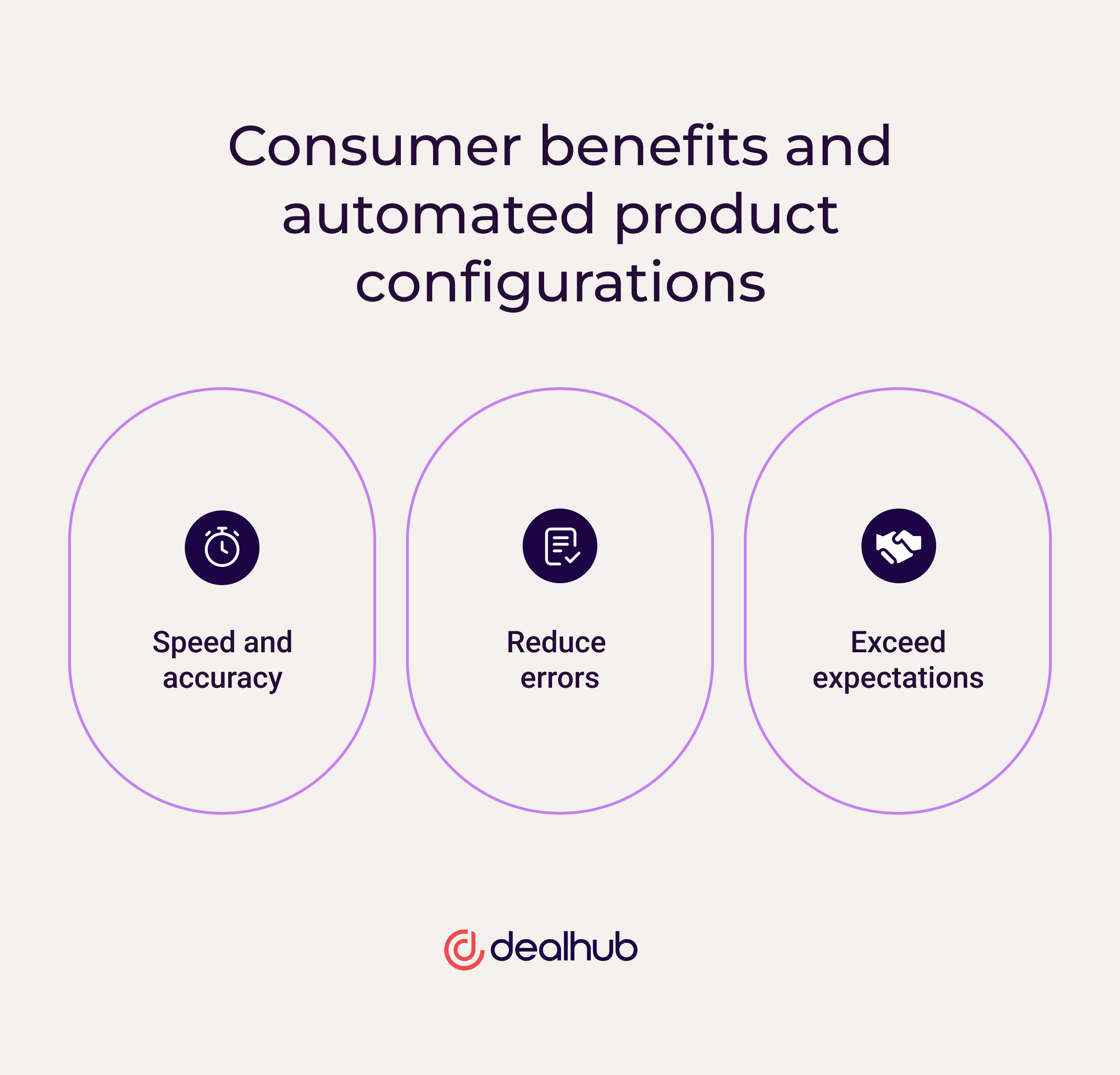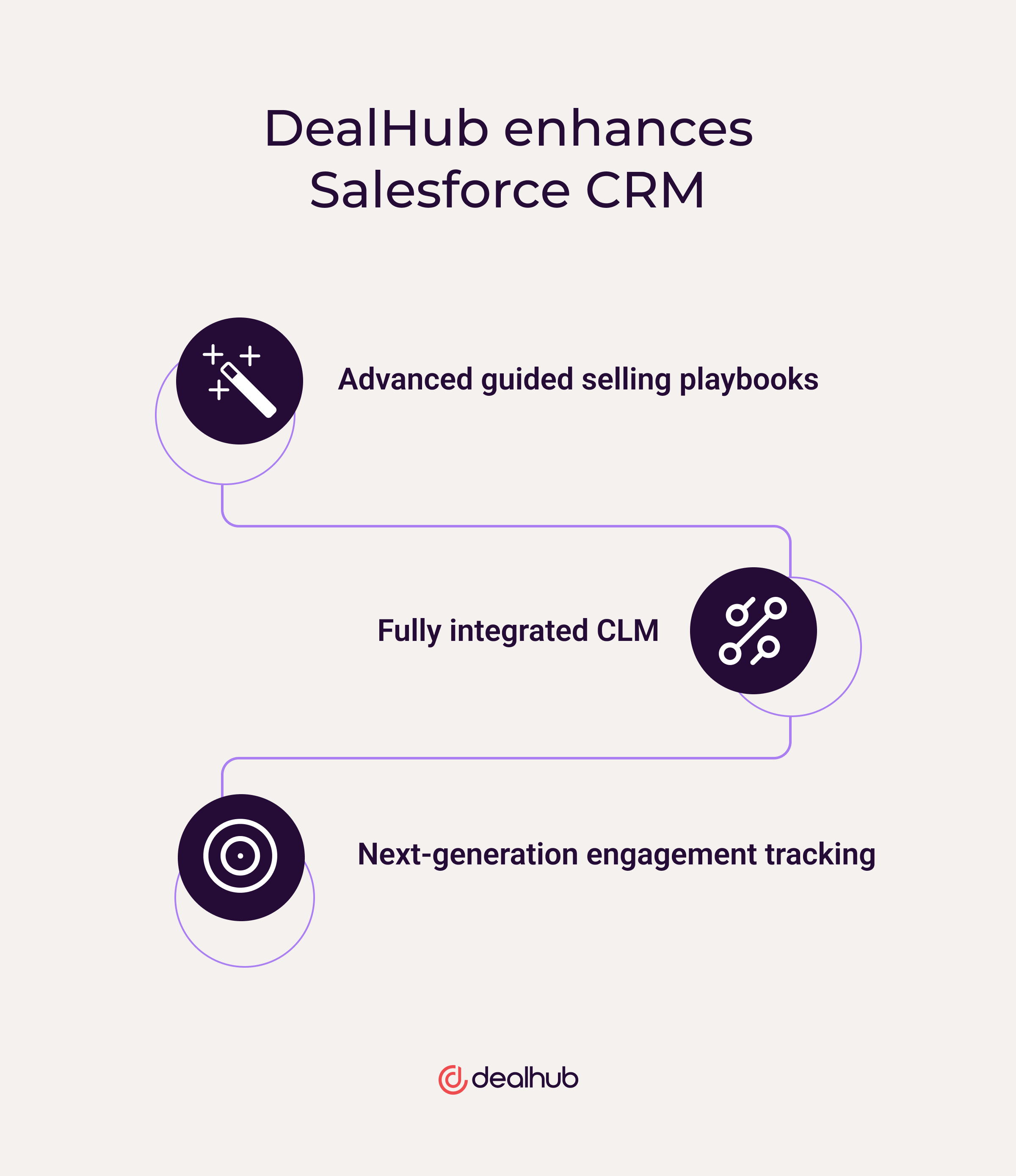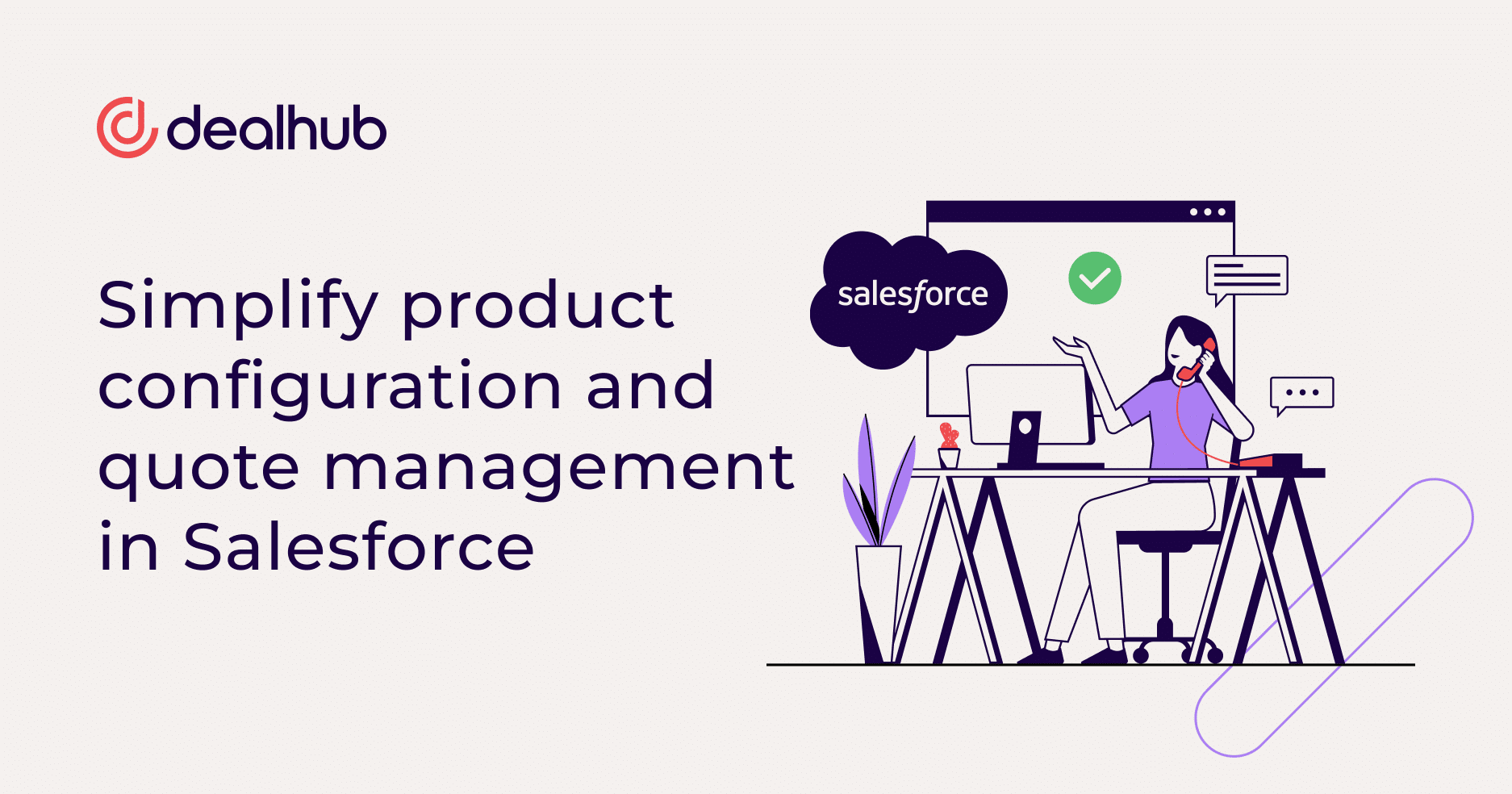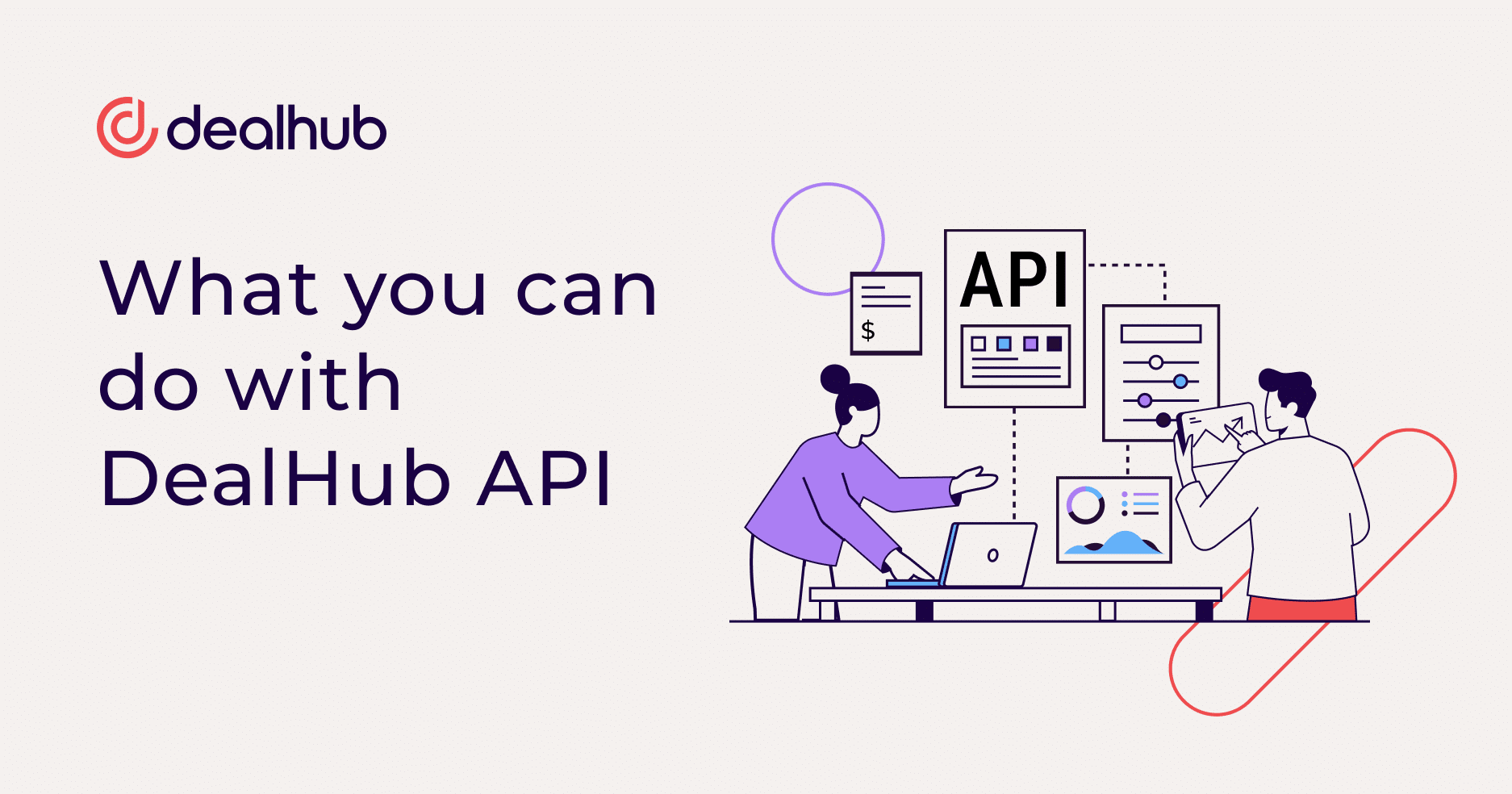This article looks at how you can use DealHub’s next-generation technology to simplify product configuration and quote management in Salesforce.
Automate product configurations in Salesforce
Automated product configuration solutions enable companies to customize offerings for consumers at scale. Although customer-facing, product configuration solutions benefit businesses as well. This is why combining Salesforce CRM with DealHub’s next-generation sales technology is so important.
Benefits to customers:
- Meeting their needs faster and more accurately
- Reducing errors during orders
- Exceeding expectations during the purchase experience, increasing customer loyalty
Benefits to businesses:
- Meeting customer needs faster and more accurately with less employee effort
- Gathering more specific data on customers and buying habits, aiding both Marketing and Sales teams
- Helping you keep accurate back-stock based on previous customer configuration behaviors
- Protecting developer time, unlike a custom solution

Automating product configurations requires adopting a technological solution that is easy to onboard. Complicated or poorly managed onboarding overwhelms staff and harms the customer experience.
The benefits of a configuration tool are clear, but the adoption process can be complex. Although Salesforce offers product configuration, its functionality is not enough to maximize the SubApprevenue impact of your pricing and product strategies.
Below, we explain how DealHub’s Salesforce integration takes the data and features of Salesforce, and turns them into a true revenue engine that you can’t get with Salesforce alone.
First, let’s take a look at the types of bundles.
Types of Salesforce product bundles
If you’re frustrated by the limitations of creating a product bundle in Salesforce CPQ, you’ll appreciate DealHub’s next-generation CPQ technology in Salesforce which optimizes product bundling. Our guided selling playbooks are the future of building bundles that maximize revenue impact. They work by allowing sales leaders to create a rules-based engine that mimics their pricing and product strategies.
In contrast, when you bundle product in Salesforce there are static options that you must configure within Salesforce’s platform limitations:
A static bundle bundles different things together in the fixed quantities with no permitted changes. Ordering chocolate chip cookie dough ice cream is an example of static bundling: You can’t ask the teenager behind the counter to hold the chocolate chips from the ice cream, because the bundled product is fixed, or “static”.
A configurable bundle is customizable (within certain limits). A build-your-own pizza section of a restaurant’s menu is an example of a configurable bundle: Working with the options listed in the menu, each person builds the pizza they desire. No two pizzas have to be the same.
A nested bundle is “a bundle inside a bundle”. Deciding to “make it a meal” at a fast food restaurant after you’ve already customized your chicken sandwich is a nested bundle: The customized chicken sandwich is a configurable bundle inside of the “combo meal” bundle.
DealHub is the better way to bundle product. It’s how today’s top-performing teams create revenue-maximizing quotes, every time, without the need for countless hours of manually digging through price lists.
Streamlining quote management right in Salesforce
DealHub CPQ improves on Salesforce’s product configuration with advanced automated quote approval workflows. Instead of simply offering the ability to create bundles, DealHub CPQ empowers sales leadership to set automatic approvals within discounting and bundling thresholds.
This sets “guardrails” around reps during the quoting process, so they have the autonomy to work on their deals and make enticing offers to prospects without the delays and morale-destroying need to request an approval every time they want to offer a discount or bundle.
This is one of the ways DealHub CPQ let’s visionary leaders protect margins while still letting their sales reps focus on selling.
In contrast, quote management in Salesforce only lets you control when sales representatives can configure bundles. This gives you freedom within set restrictions, but falls short of DealHub’s advanced guided selling/automated approvals technology.
Salesforce offers four configuration-event configuration experiences:
- Allowed-Always is for bundles customized for each sale.
- Allowed-Edit is for occasionally customized bundles.
- Disabled is for never-customizable bundles.
- Allowed-Add is a rarely used option that displays the configuration page once, to define later choices in the sales process.
Salesforce construct bundles product options
DealHub’s guiding selling playbooks offer the future of flexible selling by mapping deals onto leadership’s vision for pricing and product decisions. Our next-generation technology empowers reps to answer a series of questions about a deal and then create a 100% accurate quote in line with that strategy. It’s the future of sales enablement — one that combines automated strategic planning without automated tactical execution at every stage of the sales cycle — so forward-looking teams can gain a huge edge over their competition.
Unlike DealHub’s dynamic playbooks that create bundles optimized for every specific deal, Salesforce forces reps to use the same bundles over and over again. Leadership can use product options to construct bundles, creating preset bundles—which then become the ONLY bundles our sales staff can offer to leads.

Here’s an example:
Salesforce’s basic bundling will let you select a “lead product” and then add “product options” to add general, pre-defined bundles. For example, if a customer buys a coloring book, options might include crayons, colored pencils, or markers, all tools for coloring in the book.
Product options also will describe how the “follower” of the “lead” will behave in the bundle. In Salesforce, you can include fields like number (which lets you decide in what order the follower options will display on a sales rep’s screen) and required (which prevents a rep from deselecting a required bundle option).
However, if a sales reps sees an opportunity to create a new bundle to capitalize on a specific deal, they will not be able to do so. In contrast, DealHub’s advanced technology would be able to create an optimized bundle automatically, by mapping the details of the deal onto leadership’s defined strategy.
Determine how bundled quote lines behave after configuration
DealHub CPQ allows leadership to automatically input product dependencies into their sales strategies. Reps can use the guided selling playbooks not only to create the bundles, but also trust that the correct dependencies are taken into account when generating the quantity of each product in the bundle.
In contrast, Salesforce product configuration also requires reps to make decisions about what quantities of products will go into a bundle. This forces reps to understand exactly how many of each product are necessary. Misunderstandings (or mistakes) in determining this can lead to disastrous results, such as an adequate number of component parts not being shipped, rendering the entire product bundle useless to the customer.
Salesforce forces reps to navigate a mountain of options, simply to input a quantity that DealHub CPQ can do automatically to ensure any sales proposal delivers a bundle that works for the prospect:
Here’s what reps have to do after configuration with Salesforce:
Certain product option fields determine how bundled quote lines behave after configuration.
- A component option does the multiplication for you, when certain components must be included in each bundle unit, for example, sending two batteries along with every unit.
- An accessory option keeps a fixed quantity, regardless of the bundling.
- A related product option includes a certain quantity of a related product in the bundle, a quantity that can be changed.
Salesforce also offers a “pick-list” of settings for the Quote Line Visibility field:
- Document only hides from the Quote Line editor but shows on the output document.
- Editor only shows on the Quote Line Editor but hides on the output document.
- Never hides in both places.
- Always (or blank) displays in both places.
Customizing the Quote Line allows you to reduce confusion (is an always-included instruction manual ever a “special bundle discount”?) and provide a better user experience.
Use features to organize options
A single, giant list of bundle options creates a poor user experience. Salesforce lets you use features to organize options, grouping similar options together under separate sections. This structures bundles for a better sales experience.
To create features in Salesforce, navigate to Products > All Products. From the lead product, click “Related” and “New”. From this page, you will name the feature and enter the quantity range. After saving, add the new feature to the lead product to allow sales staff to use it.
Change the feature user experience (UX)
DealHub drives adoption rates higher by providing a seamless user experience. DealHub CPQ’s guided selling playbooks and automated quote approval workflows make sales reps’ lives easier by letting them get from quote to close faster than ever before. And our DealRoom’s next-generation sales proposal, contract management, and DealRoom microsite technology makes getting from quote-to-close easier than ever before.
DealHub’s simplicity improves on Salesforce’s complex, multi-tiered interface that forces sales reps to navigate tons of menu options when managing their deals.
Inside Salesforce, the Option Layout field on the lead product offers three values—sections, tabs, and wizards—that let you configure bundle feature displays. Sections displays features in boxes, displayed in rows. Tabs displays each feature as its own tab that users can skip around (or over). Wizard displays each feature in its own tab, and the user must continue through each tab in order without skipping.
The Feature Category lets you organize features into categories with a tab. For example, a laptop bundle might have categories like “chargers,” “accessories,” and “decoration.”
The Configuration Field Set lets you change which columns (in addition to the default quantity, product code, product name, product description, and unit price) display for each feature.
In contrast, DealHub makes selling and quote management in Salesforce easier than ever before. That’s why many of our customers boast 100% adoption rates. DealHub isn’t just a management decision; it’s an evolution in how a sales team can empower their reps to sell smarter, not harder.
A low-code approach to CPQ implementation
DealHub offers a zero-code approach that can be set up in days and fully onboarded in 3 weeks. Unlike Salesforce’s heavy code approach to CPQ and sales enablement, you don’t need to spend tons of time and money recording your entire system to meet Salesforce’s needs.
DealHub is a sales solution that will conform to your specific needs.
In contrast, Salesforce requires you to add configured code and descriptions and generate custom code and/or descriptions for dynamic internal bundle representation. These codes and descriptions are the only way other teams (like fulfillment and customer service) can quickly find precise configuration information. This forces you to create code to optimize your process.
Moreover, Trailhead explains there are additional complexities, such as making “three fields work together to construct the Package Product Code,” like “-P28” to indicate a 2.8GHz processor. In Salesforce, under Products > All Products view > [Product Name] > Related, you will edit the component code, the position, and the configured code pattern.
Removing roadblocks in product configuration and quote management
When your team needs to streamline product configuration and quote management, finding a third-party integration for your Salesforce CRM is the ticket to a better user experience and more expedient sales cycles. With DealHub’s Salesforce integration, teams gain a seamless user experience and an entire spectrum of tools to manage deal complexities with ease. Use DealHub’s unique capabilities to increase transparency, remove bottlenecks, scale with ease, and streamline your deal management for a better Salesforce experience!









